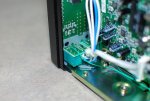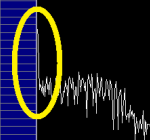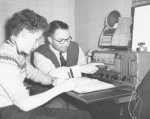What are you using to measure and graph that?
You are using an out of date browser. It may not display this or other websites correctly.
You should upgrade or use an alternative browser.
You should upgrade or use an alternative browser.
Why Do My Discriminator Taps Always Stop Working Eventually?
- Thread starter CanesFan95
- Start date
- Status
- Not open for further replies.
slicerwizard
Member
Those are P25 Phase I symbols. Each is 1/4800 sec. So the audio was in a negative state for about 0.007 sec. Aside the brief positive spikes, the signal is negative for about 0.02 sec. Any series capacitor in a discriminator tap has to "pass DC" on that sort of timescale or it will distort the signal.
That works out to a low frequency cutoff of ~50Hz. Not "near DC"...Those are P25 Phase I symbols. Each is 1/4800 sec. So the audio was in a negative state for about 0.007 sec. Aside the brief positive spikes, the signal is negative for about 0.02 sec. Any series capacitor in a discriminator tap has to "pass DC" on that sort of timescale or it will distort the signal.
RFI-EMI-GUY
Member
- Joined
- Dec 22, 2013
- Messages
- 6,868
Various discriminators will have either a positive or negative bias and potential. Pay close attention to the voltage that will appear on BOTH ends of the coupling capacitor.
slicerwizard
Member
prcguy
Member
Has the OP replaced the series cap to see if that was the problem? If the mod also included installing a jack maybe it failed from use? I would check or replace that also.
DC carries no information. It's not a part of the signal needed to decode bits properly.The massive DC component in that signal is so blindingly obvious that I shouldn't need to post a spectrum display, but here we are...
View attachment 89145
View attachment 89146
CanesFan95
Active Member
I'm not following what you guys are talkign about with all the DC stuff. What software is that in the screenshots?
I will try re-doing the whole mod from scratch and see what happen when I get some time.
I will try re-doing the whole mod from scratch and see what happen when I get some time.
prcguy
Member
Please replace one part at a time and test so you know which one was the problem.
I'm not following what you guys are talkign about with all the DC stuff. What software is that in the screenshots?
I will try re-doing the whole mod from scratch and see what happen when I get some time.
Arkmood
Member
Some hands on experience with taps:
While aware of safeguards and advantages with use of resistors/capacitors in discrim.tap applications, found them to be non-essential in a number of installations: RS2005/2006,Pro93,Pro95,Pro34,Unidenxxx - all passed raw audio to decode properly with no problems/damage for years, in the absence of... also utilized solderless taps with good results.
While aware of safeguards and advantages with use of resistors/capacitors in discrim.tap applications, found them to be non-essential in a number of installations: RS2005/2006,Pro93,Pro95,Pro34,Unidenxxx - all passed raw audio to decode properly with no problems/damage for years, in the absence of... also utilized solderless taps with good results.
Yep!Some hands on experience with taps:
While aware of safeguards and advantages with use of resistors/capacitors in discrim.tap applications, found them to be non-essential in a number of installations: RS2005/2006,Pro93,Pro95,Pro34,Unidenxxx - all passed raw audio to decode properly with no problems/damage for years, in the absence of... also utilized solderless taps with good results.
Me too. I have an old RS scanner, 2052 I think, that I tapped with absolutely nothing in series or shunt besides one series resistor (I think, I'd have to dig it out and open it up to be sure as I'm not positive if I even used a series resistor). Straight cable with shield attached to ground at scanner pcb end and 1/8 inch phone plug at the other. Worked great, no issues.
That said - you shouldn't ignore DC differentials on audio lines given unknowns at both ends.
An expensive route to go is to use DC blocks rather than regular caps. There are such animals and they pass about as far down to DC as possible without actually going to DC. But, yeah, check what you have with the right equipment and know what you're doing.
What I would suggest is just use a 1K to 5K series resistor and call it a day. The resistor provides an ok current limiter for any DC differential (potential) and adds a little crude impedance buffering for the discriminator. As long as the ac signal voltage level of the discriminator output is sufficient to drive your sink device (like a sound card input in a PC, etc. which should have a high impedance input anyway) and above the circuit noise floor enough you should be good to go. And with no cap inline no worries about low freq. cutoff or future failure of cap and polarity, etc.
-Mike
Paco-Jerte
You Member, Member!
I've had a 2006 (tapped like 10 years ago) and 996xt (tapped like 8 years ago) with no issues at all. They both still work fine,
majoco
Stirrer
I've put audio taps on both my UBCT8's that I have used for years - I had to do a search to find the input to the audio volume control and then wired that to a phono socket on the rear panel via a 10uF 16volts electrolytic capacitor, positive side to the volume control. I don't usually hang components in mid-air but the cap weighs nothing and it's not going to get vibrated in a vehicle - never gone wrong.






I have units that I added a discriminator tap to over decades ago that are still working. As I write this I am using a PRO-95 to feed UniTrunker.
I am not sure why people are trying to preserve the DC component of a discriminator output. The output is essentially audio. I feed that audio into an input on a PC (line/mic). All inputs are not created equal as some may have input DC blocking and some may not. I've always felt the discriminator output should have a capacitor to block DC, and as written above, it should be non-polarized. Don't under-spec the cap; I'm using caps with a voltage rating of at least 10V. Cheap caps (from China) have a shorter life than better quality components.
I am not sure why people are trying to preserve the DC component of a discriminator output. The output is essentially audio. I feed that audio into an input on a PC (line/mic). All inputs are not created equal as some may have input DC blocking and some may not. I've always felt the discriminator output should have a capacitor to block DC, and as written above, it should be non-polarized. Don't under-spec the cap; I'm using caps with a voltage rating of at least 10V. Cheap caps (from China) have a shorter life than better quality components.
prcguy
Member
You don't need to preserve the DC component but you do have to preserve a digital leading or trailing edge and that requires a frequency response near DC. It all depends on what your are going to feed from the discriminator.
Many years ago I had to adapt repeater community tone panels to various radios by tapping off the discriminator. In systems where only PL tones were used it was not that critical, the lowest frequency is 67Hz and a 1uf series cap would usually work due to the high impedance input of the tone panel. On systems that had DPL, which has a 134Hz digital word that needs to be fairly square wave, I had to up the amount of capacitance and experiment to preserve the square wave. The value of capacitor and other components was very critical and if done wrong you get no DPL decoding.
On other stuff I've worked on a DC offset will actually eat up some of the least significant bits, either wreaking the dynamic range of a digital signal or loosing important information where it just doesn't work any more. Some equipment had elaborate DC offset adjustments that had to be performed periodically or the DC would creep in again and wreak the circuit.
Not sure if whatever people are feeding downstream of their scanner is sensitive to DC offset, but some stuff is.
Many years ago I had to adapt repeater community tone panels to various radios by tapping off the discriminator. In systems where only PL tones were used it was not that critical, the lowest frequency is 67Hz and a 1uf series cap would usually work due to the high impedance input of the tone panel. On systems that had DPL, which has a 134Hz digital word that needs to be fairly square wave, I had to up the amount of capacitance and experiment to preserve the square wave. The value of capacitor and other components was very critical and if done wrong you get no DPL decoding.
On other stuff I've worked on a DC offset will actually eat up some of the least significant bits, either wreaking the dynamic range of a digital signal or loosing important information where it just doesn't work any more. Some equipment had elaborate DC offset adjustments that had to be performed periodically or the DC would creep in again and wreak the circuit.
Not sure if whatever people are feeding downstream of their scanner is sensitive to DC offset, but some stuff is.
I have units that I added a discriminator tap to over decades ago that are still working. As I write this I am using a PRO-95 to feed UniTrunker.
I am not sure why people are trying to preserve the DC component of a discriminator output. The output is essentially audio. I feed that audio into an input on a PC (line/mic). All inputs are not created equal as some may have input DC blocking and some may not. I've always felt the discriminator output should have a capacitor to block DC, and as written above, it should be non-polarized. Don't under-spec the cap; I'm using caps with a voltage rating of at least 10V. Cheap caps (from China) have a shorter life than better quality components.
CanesFan95
Active Member
OK, so what do you guys think I should do? What value resister and capacitor should I use and should it be polarized?
slicerwizard
Member
So the +/- 12VDC levels commonly used in RS232 signaling are superfluous? We can start adding series caps to RS323 data lines?DC carries no information. It's not a part of the signal needed to decode bits properly.
Y'all are too focused on two level signaling. Taps are commonly used for four level signaling like NXDN, DMR, P25 and so on. DC levels absolutely matter.You don't need to preserve the DC component but you do have to preserve a digital leading or trailing edge and that requires a frequency response near DC. It all depends on what your are going to feed from the discriminator.
CanesFan95
Active Member
Whoosh!! Right over my head, once again. Why do you guys learn all this at?
majoco
Stirrer
- Status
- Not open for further replies.
Similar threads
- Replies
- 8
- Views
- 922
- Replies
- 3
- Views
- 724
- Replies
- 24
- Views
- 3K
- Replies
- 28
- Views
- 6K




